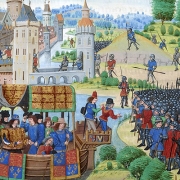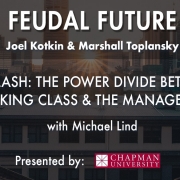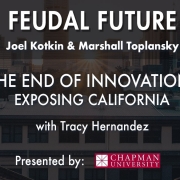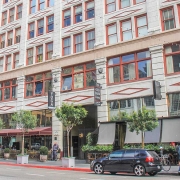Our Neo-Feudal Future
America has only a limited feudal past, the plantation aristocracy of the antebellum South and the enormous class chasms of the Gilded Age being pretty much our only examples. Yet today—after decades of social mobility, a digital revolution that was supposed to empower individuals everywhere, and the construction of a vigorous anti-discrimination apparatus that putatively ensures equal rights and status—a rigid new social order with feudal elements has come into view.
This emerging class structure reprises, albeit with far less starvation, the patterns of the Middle Ages, with each class performing distinct social functions and defined economic roles. In this new order, there are two ascendant classes: the oligarchs and the clerisy. And there are two classes struggling to serve the ascendant classes, and to maintain for themselves a decent standard of living: the yeomanry and the new serfs.
The old feudal order evolved gradually, as the last structures of Roman republicanism first weakened, then totally collapsed due to the barbarian invasions. The seizure of Europe by the barbarian hordes upended an entire civilization, including its class structures. The collapse was due as much to the weakness of Roman institutions as to the ruthlessness of barbarian leaders. The feudalism that ensued would simplify society under the rule of two classes, the military aristocracy and the clerical class, while most people lived essentially in bondage to one or the other.
This historical precedent can help us make sense of the socioeconomic trends of America’s last half-century. Since the 1970s, the wealth differential between middle-income and upper-income households in the United States has grown. Data from the Census Bureau show that the share of national income going to the middle 60 percent of households has fallen to a record low. Wealth gains in recent decades have been made overwhelmingly by the top 1 percent of households, especially the top 0.5 percent. In 1945–73, the top 1 percent in America captured just 4.9 percent of total U.S. income growth; in the following two decades, this super-rich cohort gobbled up the majority of it. The combined wealth of the richest four hundred Americans now exceeds the total wealth of 185 million of their fellow citizens. Over the past three decades, the share of household wealth owned by the top 0.1 percent has increased from 7 percent to 22 percent.
This pattern has been accelerated by the pandemic. The number of millionaires around the world jumped to 56.1 million in 2021, with 5.2 million joining the group last year, according to the 2021 Credit Suisse Global Wealth Report. The number of ultra-high net worth individuals—those with a net worth above $50 million—grew by 24 percent, to 215,030. Last year, Amazon tripled its profits and Jeff Bezos made $70 billion; billionaires overall have earned more than $1 trillion since March. Alphabet, Amazon, Apple, Facebook, and Microsoft now make up 20 percent of the American stock market’s total value. As one Silicon Valley wag put it, America increasingly resembles “feudalism with better marketing.”
The similarities are not just material. In the Middle Ages, the aristocracy shared common views. Kings and chieftains fought over land and gold, but rarely (until the Reformation) ideas and truths. The ideals of a pluralistic society wouldn’t have meant anything to them, nor would John Stuart Mill’s marketplace of ideas. Now, after two centuries of an Enlightenment-influenced public square hot with dissent and debate, we observe the emergence of a singular mindset among the academy and the media—today’s clerisy—and the oligarchic elite. In the past, political views, religious beliefs, and special interests divided the elite and forced different factions to persuade and cajole and convince the masses of their respective sanctions. Every major city had multiple newspapers with distinct lines on current events, serving as organs for rival powers. Pro-slavery versus anti-slavery, labor versus management, Wall Street versus the farmers, interventionists versus isolationists: It’s a history of ideological conflict.
No such broad conflict exists among today’s nobility. They are unified in their progressive outlook on all things social and cultural. In the Middle Ages, the aristocracy often found allies among the Catholic clergy, who were willing to back the great landowners’ laws and swords with doctrines and rationales. There is a twenty-first-century clerisy, though it is rarely religious and operates in a secular consumer society. Its members aren’t priests. They are journalists, entertainers, credentialed professionals, and teachers. They provide the images, narratives, arguments, and artworks that reinforce the binding outlook, and they police dissenters as vigilantly as did the Inquisitors of old (though fortunately, so far, less lethally).
As society becomes more regulated and more dependent on expertise, the clerisy grows. Michael Lind estimates that this “overclass” constitutes some 15 percent of the American workforce, a far larger portion than the membership of the old First Estate (closer to 1 percent of the French population). Charles Murray describes them more narrowly as the top echelons in law, government, university, and media—roughly 2.4 million people in a country of more than 320 million.
Until the last four decades, the yeoman class—James Madison’s small proprietors—were America’s ascendant socioeconomic group. A study covering the United Kingdom, the Netherlands, and the United States shows that all three saw a rapid decline in the concentration of wealth from the 1820s through the 1970s. Never before had so much prosperity and relative security been so widely enjoyed.
Now, the numbers and influence of the yeomanry are declining. They still represent close to 50 percent of the population, notes Pew—a drop from 61 percent in 1971. Globalization has savaged many middle-class jobs, whether in factories or in services, transferring employment to China, India, and other developing countries. In many countries, immigration, much of it from poor countries, has undermined wage rates, particularly for lower-skilled workers, but now for professionals as well. Much of the global middle class is heavily in debt, mainly because of high housing costs.
In the United States, long known as the land of opportunity, the chance of middle-class earners’ moving to the top rungs of the earnings ladder has dropped by approximately 20 percent since the early 1980s. The pandemic has been particularly hard on this class. Though large chains have reported record sales during the lockdowns, more than 160,000 small businesses have closed. A survey by the advocacy group Main Street America predicts that as many as 7.5 million small businesses will go out of business by the time the crisis is over. By some estimates, upwards of one-third of small businesses will close down permanently.
The fall of the yeomanry poses a major threat to representative democracy. Once again, history provides a precedent. In Imperial Rome, small farmers and artisans were steadily displaced by slaves imported from the far ends of the expanding empire. Increasingly, occupations and social status came to be determined by heredity. By the end of the Republic, more than 75 percent of all property was owned by roughly 3 percent of the population, while more than four-fifths owned no property at all. Inequality paved the way for the feudal future.
The great social achievement of the mid- to late twentieth century lay in the movement of working-class, propertyless people, including minorities, into the ranks of business owners and homeowners. Today the flow runs in the opposite direction, as prospects for joining the middle class have declined and opportunities for advancement have dried up for everyone outside the professional and elite capitalist classes.
Working-class people, of whatever race, suffer the worst health-related impacts and have paid the most in lives during the pandemic. The same holds economically. In the U.S., roughly half of all job losses last April were in such low-paying fields as restaurants, hotels, and amusement parks; information and finance jobs were barely touched. Almost 40 percent of Americans making less than $40,000 a year lost their jobs in the pandemic, as the wage gains made during the first two years of the Trump Administration have largely evaporated.
Read the rest of this piece at First Things.
Joel Kotkin is the author of The Coming of Neo-Feudalism: A Warning to the Global Middle Class. He is the Roger Hobbs Presidential Fellow in Urban Futures at Chapman University and Executive Director for Urban Reform Institute. Learn more at joelkotkin.com and follow him on Twitter @joelkotkin.
Homepage photo: ILO Asia-Pacific Flickr under CC 3.0 License.









